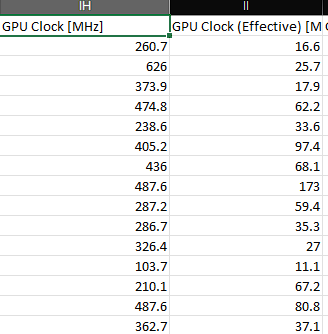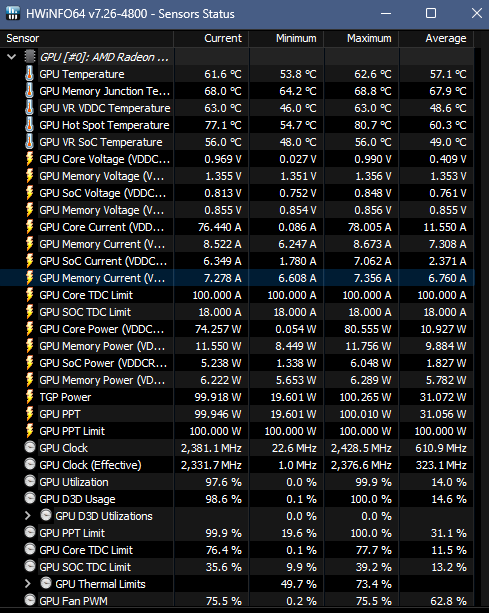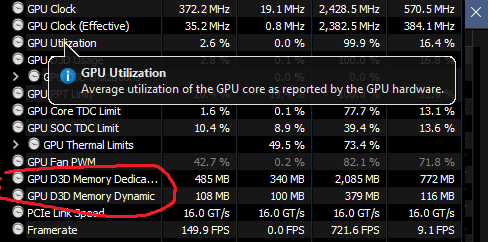DoctorVoltabolt
New Member
- Joined
- Jun 23, 2022
- Messages
- 6 (0.01/day)
I tried overclocking my new RX 6600 following the simplest of OC guides (increment clock by small amounts in MSI Afterburner, stress test after every increment). I was doing this for all of today, and got from 2684mhz to 2810mhz (24mhz increments) with zero problems both in MSI Kombustor's and 3DMark's stress tests (Time Spy and Fire Strike Extreme). Then I had to use the computer for other stuff, so I stopped there and turned it back down temporarily. Temperatures during the tests peaked at 70C.
After that, I turned on a game, and immediately encountered heavy stuttering. Steam's FPS counter showed the usual FPS for that game, but I couldn't even turn the camera around without it semi-freezing (despite the FPS counter not reacting to that in any way). At this point, all my Afterburner settings were back to the way they were initially.
I tried another less demanding game. 99% normal, very slight stuttering sometimes.
I tried launching another game that is much, much less demanding than the previous two, I think it could easily run on an Intel HD graphics (osu!). It was literally unplayable. 10fps, and the cursor freezes every half a second. Of course I tried fiddling with the game's settings, to no avail.
What I tried so far, in order :
I also thought about inserting the card into a different PC to check if it works fine. If not, then the card itself is somehow damaged, and if it does then the only thing I can think of doing is reinstalling Windows completely.
If anyone has any better ideas on what to do or what I could've messed up during the OC process, I'll be very thankful...my process was as described above, with power limit at +20% (maximum allowed by the card), temp limit unchanged (card doesn't allow tweaking it) and custom fan curve with fans at 100% after 75C, it never got that high though. The only thing I changed was the core clock, I haven't touched the voltage or even the memory clock. Could I have even messed up the hardware this way?
After that, I turned on a game, and immediately encountered heavy stuttering. Steam's FPS counter showed the usual FPS for that game, but I couldn't even turn the camera around without it semi-freezing (despite the FPS counter not reacting to that in any way). At this point, all my Afterburner settings were back to the way they were initially.
I tried another less demanding game. 99% normal, very slight stuttering sometimes.
I tried launching another game that is much, much less demanding than the previous two, I think it could easily run on an Intel HD graphics (osu!). It was literally unplayable. 10fps, and the cursor freezes every half a second. Of course I tried fiddling with the game's settings, to no avail.
What I tried so far, in order :
- Restarting computer, obviously did not work
- Reinstalling drivers the normal way, did not work
- Deleting MSI Afterburner and then reinstalling drivers the normal way, did not work
- Deleting my drivers via DDU in Safe Mode, then reinstalling drivers (22.5.2) through AMD's Adrenalin Software. This fixed all problems...for several hours. I changed absolutely nothing, and in ~6 hours everything went back to being exactly the way I described above. I'm completely stumped now.
- Deleting my drivers via DDU in Safe Mode again, then reinstalling a different version of the drivers (tried both 22.5.1 and the beta drivers Windows installs automatically). This didn't work at all, not even temporarily.
I also thought about inserting the card into a different PC to check if it works fine. If not, then the card itself is somehow damaged, and if it does then the only thing I can think of doing is reinstalling Windows completely.
If anyone has any better ideas on what to do or what I could've messed up during the OC process, I'll be very thankful...my process was as described above, with power limit at +20% (maximum allowed by the card), temp limit unchanged (card doesn't allow tweaking it) and custom fan curve with fans at 100% after 75C, it never got that high though. The only thing I changed was the core clock, I haven't touched the voltage or even the memory clock. Could I have even messed up the hardware this way?






